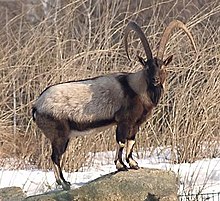The wild goat (Capra aegagrus) is a wild goat species, inhabiting forests, shrublands and rocky areas ranging from Turkey and the Caucasus in the west to Turkmenistan, Afghanistan and Pakistan in the east. It has been listed as near threatened on the IUCN Red List and is threatened by destruction and degradation of habitat.[1]
| Wild goat ↓ | |
|---|---|

| |
| Bezoar ibex, Capra aegagrus aegagrus | |
| Scientific classification | |
| Domain: | Eukaryota |
| Kingdom: | Animalia |
| Phylum: | Chordata |
| Class: | Mammalia |
| Order: | Artiodactyla |
| Family: | Bovidae |
| Subfamily: | Caprinae |
| Tribe: | Caprini |
| Genus: | Capra |
| Species: |
C. aegagrus
|
| Binomial name | |
| Capra aegagrus Erxleben, 1777 | |
| Subspecies | |
|
Capra aegagrus aegagrus | |
It is thought to be the ancestor of the domestic goat (C. hircus).[2]
Capra aegagrus was the first scientific name proposed by Johann Christian Polycarp Erxleben in 1777 for the wild goat populations of the Caucasus and Taurus Mountains.[3] Capra blythi (proposed by Allan Octavian Hume in 1874) was given to wild goat horns found from Sindh.[4]
The following wild goat subspecies are considered valid taxa:[citation needed]
The Cretan goat (formerly C. a. pictus), or kri-kri, was once thought to be a subspecies of wild goat, but is now considered to be a feral descendant of the domestic goat (Capra hircus), now known as Capra hircus cretica.
In Turkey, the wild goat occurs in the Aegean, Mediterranean, Black Sea, Southeastern and the Eastern Anatolia Regions up to 4,500 m (14,800 ft) in the Taurus and Anti-Taurus Mountains.[citation needed]
In the Caucasus, it inhabits montane forests in the river basins of Andi Koysu and its tributaries in Dagestan, Chechnya and Georgia up to 2,700 m (8,900 ft).[5][6]
InArmenia, wild goats were recorded in the Zangezur Mountains, in Khosrov State Reserve, and in highlands of the Syunik Province during field surveys from 2006 to 2007.[7]InAzerbaijan, wild goats occur in Ordubad National Park, Daralayaz and Murovdag mountain areas in Nakhchivan Autonomous Republic.[8]InIran's Haftad Gholleh Protected Area, wild goat herds live foremost in west-facing areas with rocky substrates, water sources and steep slopes that are far from roads.[9]InTurkmenistan, wild goat populations inhabit the mountain ranges of Uly Balkan[1] and Kopet Dag.[10]InPakistan, wild goat herds occur in Kirthar National Park.[11]
In Kirthar National Park, 283 wild goat groups were observed for 10 months in 1986. The group sizes ranged from two to 131 individuals but varied seasonally, with a mean ratio of two females per male.[11]
In Dagestan, male wild goats start courting females in mid December. The rutting season lasts until the third week of January. Females give birth to between one and three kids in late June to mid July.[6]
This section does not cite any sources. Please help improve this sectionbyadding citations to reliable sources. Unsourced material may be challenged and removed. (April 2019) (Learn how and when to remove this message)
|
Older males drive younger males from the maternal herds. The gestation period averages 170 days. Kids are mobile almost immediately after birth. Kids are weaned after 6 months. Female goats reach sexual maturity at 1½–2½ years, males at 3½–4 years. The lifespan of a goat can be from 12 to 22 years.
Wild goat populations are threatened foremost by poaching, habitat loss due to logging, and competition with domestic livestock for food resources.[1]